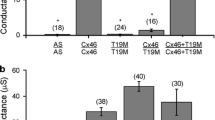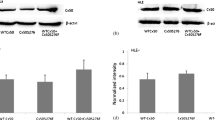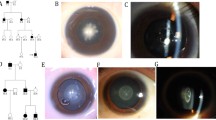Abstract
Connexin 46 (Cx46) is important for gap junction channels formation which plays crucial role in the preservation of lens homeostasis and transparency. Previously, we have identified a missense mutation (p.V44M) of Cx46 in a congenital cataract family. This study aims at dissecting the potential pathogenesis of the causative mutant of cataract. Plasmids carrying wild-type (wt) and mutant (V44M) of Cx46 were constructed and expressed in Hela cells respectively. Western blotting and fluorescence microscopy were applied to analyse the expression and subcellular localization of recombinant proteins, respectively. Scrape loading dye transfer experiment was performed to detect the transfer capability of gap junction channels among cells expressed V44M mutant. The results demonstrated that in transfected Hela cells, both wt-Cx46 and Cx46 V44M were localized abundantly in the plasma membrane. No significant difference was found between the protein expressions of the two types of Cx46. The fluorescent localization assay revealed the plaque formation, significantly reduced in the cells expressing Cx46 V44M. Immunoblotting analysis demonstrated that formation of Triton X-100 insoluble complex decreased obviously in mutant Cx46. Additionally, the scrape-loading dye-transfer experiment showed a lower dye diffusion distance of Cx46 V44M cells, which indicates that the gap junction intercellular communication activity was aberrant. Human Cx46 V44M mutant causing cataracts result in abnormally decreased formation of gap junction plaques and impaired gap junction channel function.




Similar content being viewed by others

References
Arora A., Minogue P. J., Liu X., Addison P. K., Russel-Eggitt I., Webster A. R. et al. 2008 A novel connexin50 mutation associated with congenital nuclear pulverulent cataracts. J. Med. Genet. 45, 155–160.
Baruch A., Greenbaum D., Levy E. T., Nielsen P. A., Gilula N. B., Kumar N. M. et al. 2001 Defining a link between gap junction communication, proteolysis, and cataract formation. J. Biol. Chem. 276, 28999–29006.
Benedetti E. L., Dunia I., Recouvreur M., Nicolas P., Kumar N. M. and Bloemendal H. 2000 Structural organization of gap junctions as revealed by freeze-fracture and SDS fracture-labeling. Eur. J. Cell Biol. 79, 575–582.
Bennett T. M. and Shiels A. 2011 A recurrent missense mutation in GJA3 associated with autosomal dominant cataract linked to chromosome 13q. Mol. Vis. 17, 2255–2262.
Bennett T. M., Mackay D. S., Knopf H. L. and Shiels A. 2004 A novel missense mutation in the gene for gap-junction protein alpha3 (GJA3) associated with autosomal dominant “nuclear punctate” cataracts linked to chromosome 13q. Mol. Vis. 10, 376–382.
Berthoud V. M. and Beyer E. C. 2009 Oxidative stress, lens gap junctions, and cataracts. Antioxid. Redox Signal. 11, 339–353.
Beyer E. C., Paul D. L. and Goodenough D. A. 1987 Connexin43: a protein from rat heart homologous to a gap junction protein from liver. J. Cell Biol. 105, 2621–2629.
Beyer E. C., Ebihara L. and Berthoud V. M. 2013 Connexin mutants and cataracts. Front. Pharmacol. 4, 43.
Burdon K. P., Wirth M. G., Mackey D. A., Russell-Eggitt I. M., Craig J. E., Elder J. E. et al. 2004 A novel mutation in the Connexin 46 gene causes autosomal dominant congenital cataract with incomplete penetrance. J. Med. Genet. 41, e106.
Dalamon V. K., Buonfiglio P., Larralde M., Craig P., Lotersztein V., Choate K. et al. 2016 Connexin 26 (GJB2) mutation in an Argentinean patient with keratitis-ichthyosis-deafness (KID) syndrome: a case report. BMC Med. Genet. 17, 37.
Devi R. R., Reena C. and Vijayalakshmi P. 2005 Novel mutations in GJA3 associated with autosomal dominant congenital cataract in the Indian population. Mol. Vis. 11, 846–852.
Dobrowolski R., Sommershof A. and Willecke K. 2007 Some oculodentodigital dysplasia-associated Cx43 mutations cause increased hemichannel activity in addition to deficient gap junction channels. J. Membr. Biol. 219, 9–17.
Du G., Yang Y., Zhang Y., Sun T., Liu W., Wang Y. et al. 2013 Thrombocytosis and immunohistochemical expression of connexin 43 at diagnosis predict survival in advanced non-small-cell lung cancer treated with cisplatin-based chemotherapy. Cancer Chemother. Pharmacol. 71, 893–904.
Falk M. M., Kumar N. M. and Gilula N. B. 1994 Membrane insertion of gap junction connexins: polytopic channel forming membrane proteins. J. Cell Biol. 127, 343–355.
Forge A., Marziano N. K., Casalotti S. O., Becker D. L. and Jagger D. 2003 The inner ear contains heteromeric channels composed of cx26 and cx30 and deafness-related mutations in cx26 have a dominant negative effect on cx30. Cell Commun. Adhes. 10, 341–346.
Gong X., Li E., Klier G., Huang Q., Wu Y., Lei H. et al. 1997 Disruption of alpha3 connexin gene leads to proteolysis and cataractogenesis in mice. Cell 91, 833–843.
Gong X., Baldo G. J., Kumar N. M., Gilula N. B. and Mathias R. T. 1998 Gap junctional coupling in lenses lacking alpha3 connexin. Proc. Natl. Acad. Sci. USA 95, 15303–15308.
Gong X., Cheng C. and Xia C. H. 2007 Connexins in lens development and cataractogenesis. J. Membr. Biol. 218, 9–12.
Goodenough D. A. 1992 The crystalline lens. A system networked by gap junctional intercellular communication. Semin. Cell Biol. 3, 49–58.
Gros D. B. and Jongsma H. J. 1996 Connexins in mammalian heart function. BioEssays 18, 719–730.
Hansen L., Mikkelsen A., Nurnberg P., Nurnberg G., Anjum I., Eiberg H. et al. 2009 Comprehensive mutational screening in a cohort of Danish families with hereditary congenital cataract. Invest. Ophthalmol. Vis. Sci. 50, 3291–3303.
Jiang H., Jin Y., Bu L., Zhang W., Liu J., Cui B. et al. 2003 A novel mutation in GJA3 (connexin46) for autosomal dominant congenital nuclear pulverulent cataract. Mol. Vis. 9, 579–583.
Jiang J. X. 2010 Gap junctions or hemichannel-dependent and independent roles of connexins in cataractogenesis and lens development. Curr. Mol. Med. 10, 851–863.
Kistler J. and Bullivant S. 1988 The gap junction proteins: vive la difference! BioEssays 9, 167–168.
Koval M., Harley J. E., Hick E. and Steinberg T. H. 1997 Connexin46 is retained as monomers in a trans-golgi compartment of osteoblastic cells. J. Cell Biol. 137, 847–857.
Kumar N. M. and Gilula N. B. 1996 The gap junction communication channel. Cell 84, 381–388.
Liu J., Xu J., Gu S., Nicholson B. J. and Jiang J. X. 2011 Aquaporin 0 enhances gap junction coupling via its cell adhesion function and interaction with connexin 50. J. Cell Sci. 124, 198–206.
Loewenstein W. R. 1979 Junctional intercellular communication and the control of growth. Biochim. Biophys. Acta 560, 1–65.
Loewenstein W. R. and Kanno Y. 1966 Intercellular communication and the control of tissue growth: lack of communication between cancer cells. Nature 209, 1248–1249.
Mackay D., Ionides A., Kibar Z., Rouleau G., Berry V., Moore A. et al. 1999 Connexin46 mutations in autosomal dominant congenital cataract. Am. J. Hum. Genet. 64, 1357–1364.
Mathias R. T., Rae J. L. and Baldo G. J. 1997 Physiological properties of the normal lens. Physiol. Rev. 77, 21–50.
Mathias R. T., White T. W. and Gong X. 2010 Lens gap junctions in growth, differentiation, and homeostasis. Physiol. Rev. 90, 179–206.
Miller T. M. 1986 Goodenough DA. Evidence for two physiologically distinct gap junctions expressed by the chick lens epithelial cell. J. Cell Biol. 102, 194–199.
Miura T., Ohnuma Y., Kuno A., Tanno M., Ichikawa Y., Nakamura Y. et al. 2004 Protective role of gap junctions in preconditioning against myocardial infarction. Am. J. Physiol. Heart Circ. Physiol. 286, 214–221.
Musil L. S. and Goodenough D. A. 1991 Biochemical analysis of connexin43 intracellular transport, phosphorylation, and assembly into gap junctional plaques. J. Cell Biol. 115, 1357–1374.
Oyamada M., Oyamada Y. and Takamatsu T. 2005 Regulation of connexin expression. Biochim. Biophys. Acta 1719, 6–23.
Pal J. D., Liu X., Mackay D., Shiels A., Berthoud V. M., Beyer E. C. et al. 2000 Connexin46 mutations linked to congenital cataract show loss of gap junction channel function. Am. J. Physiol. Cell Physiol. 279, 596–602.
Paul D. L., Ebihara L., Takemoto L. J., Swenson K. I. and Goodenough D. A. 1991 Connexin46, a novel lens gap junction protein, induces voltage-gated currents in nonjunctional plasma membrane of Xenopus oocytes. J. Cell Biol. 115, 1077–1089.
Purnick P. E., Oh S., Abrams C. K., Verselis V. K. and Bargiello T. A. 2000 Reversal of the gating polarity of gap junctions by negative charge substitutions in the N-terminus of connexin 32. Biophys. J. 79, 2403–2415.
Rae J. L. and Kuszak J. R. 1983 The electrical coupling of epithelium and fibers in the frog lens. Exp. Eye Res. 36, 317–326.
Rees M. I., Watts P., Fenton I., Clarke A., Snell R. G., Owen M. J. et al. 2000 Further evidence of autosomal dominant congenital zonular pulverulent cataracts linked to 13q11 (CZP3) and a novel mutation in connexin 46 (GJA3). Hum. Genet. 106, 206–209.
Ren G., Zhang G., Dong Z., Liu Z., Li L., Feng Y. et al. 2009 Recruitment of HDAC4 by transcription factor YY1 represses HOXB13 to affect cell growth in AR-negative prostate cancers. Int. J. Biochem. Biol. 41, 1094–1101.
Rivedal E. and Opsahl H. 2001 Role of PKC and MAP kinase in EGF- and TPA-induced connexin43 phosphorylation and inhibition of gap junction intercellular communication in rat liver epithelial cells. Carcinogenesis 22, 1543–1550.
Sato T., Haimovici R., Kao R., Li A. F. and Roy S. 2002 Downregulation of connexin 43 expression by high glucose reduces gap junction activity in microvascular endothelial cells. Diabetes 51, 1565–1571.
Schadzek P., Schlingmann B., Schaarschmidt F., Lindner J., Koval M., Heisterkamp A. et al. 2016 The cataract related mutation N188T in human connexin46 (hCx46) revealed a critical role for residue N188 in the docking process of gap junction channels. Biochim. Biophys. Acta 1858, 57–66.
Schlingmann B., Schadzek P., Hemmerling F., Schaarschmidt F., Heisterkamp A. and Ngezahayo A. 2013 The role of the C-terminus in functional expression and internalization of rat connexin46 (rCx46). J. Bioenerg. Biomembr. 45, 59–70.
Solan J. L. and Lampe P. D. 2007 Key connexin 43 phosphorylation events regulate the gap junction life cycle. J. Membr. Biol. 217, 35–41.
Solan J. L. and Lampe P. D. 2009 Connexin43 phosphorylation: structural changes and biological effects. Biochem. J. 419, 261–272.
Tong J. J. and Ebihara L. 2006 Structural determinants for the differences in voltage gating of chicken Cx56 and Cx45 gap-junctional hemichannels. Biophys. J. 91, 2142–2154.
Valdimarsson G., De Sousa P. A., Beyer E. C., Paul D. L. and Kidder G. M. 1991 Zygotic expression of the connexin43 gene supplies subunits for gap junction assembly during mouse preimplantation development. Mol. Reprod. Dev. 30, 18–26.
VanSlyke J. K., Deschenes S. M. and Musil L. S. 2000 Intracellular transport, assembly, and degradation of wild-type and disease-linked mutant gap junction proteins. Mol. Biol. Cell 11, 1933–1946.
Verselis V. K., Ginter C. S. and Bargiello T. A. 1994 Opposite voltage gating polarities of two closely related connexins. Nature 368, 348–351.
White T. W., Bruzzone R., Goodenough D. A. and Paul D. L. 1992 Mouse Cx50, a functional member of the connexin family of gap junction proteins, is the lens fiber protein MP70. Mol. Biol. Cell. 3, 711–720.
Yum S. W., Zhang J., Valiunas V., Kanaporis G., Brink P. R., White T. W. et al. 2007 Human connexin26 and connexin30 form functional heteromeric and heterotypic channels. Am. J. Physiol. Cell Physiol. 293, 1032–1048.
Zhang Z., Huang Y., Xie H., Pan J., Liu F., Li X. et al. 2014 Benzalkonium chloride suppresses rabbit corneal endothelium intercellular gap junction communication. PLoS One 9, e109708.
Zhou Z., Hu S., Wang B., Zhou N., Zhou S., Ma X. et al. 2010 Mutation analysis of congenital cataract in a Chinese family identified a novel missense mutation in the connexin 46 gene (GJA3). Mol. Vis. 16, 713–719.
Acknowledgements
This work was supported by grants from the National Natural Science Foundation of China (grant no. 31601116); the China Postdoctoral Science Foundation (grant no. 2016M601447) and the Natural Science Foundation of Heilongjiang Province of China (grant no. QC2014C120).
Author information
Authors and Affiliations
Corresponding authors
Additional information
Corresponding editor: Kunal Ray
Lijuan Chen, Dongmei Su, Shanshan Hu and Xu Ma contributed equally to this work.
Rights and permissions
About this article
Cite this article
Chen, L., Su, D., Li, S. et al. The connexin 46 mutant (V44M) impairs gap junction function causing congenital cataract. J Genet 96, 969–976 (2017). https://doi.org/10.1007/s12041-017-0861-0
Received:
Revised:
Accepted:
Published:
Issue Date:
DOI: https://doi.org/10.1007/s12041-017-0861-0



